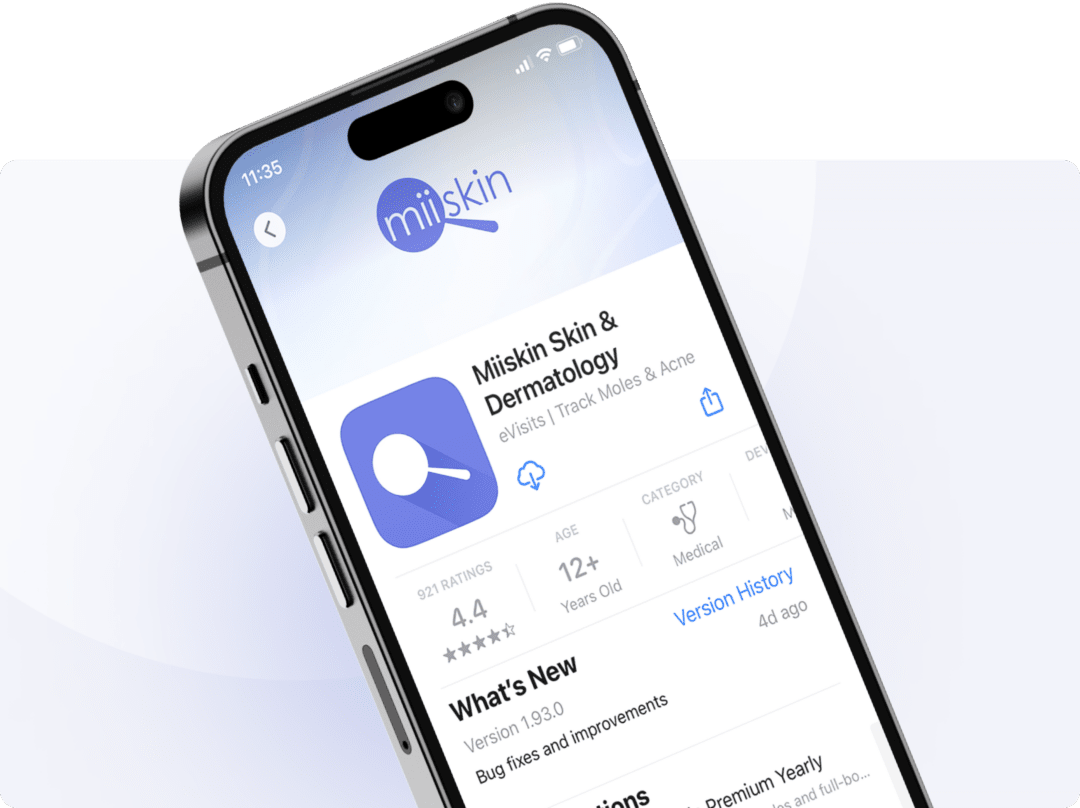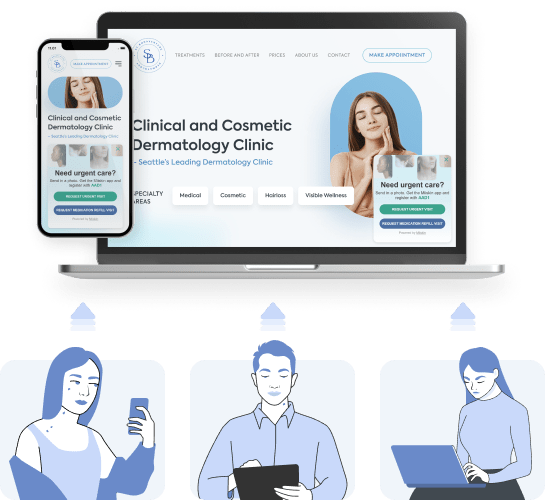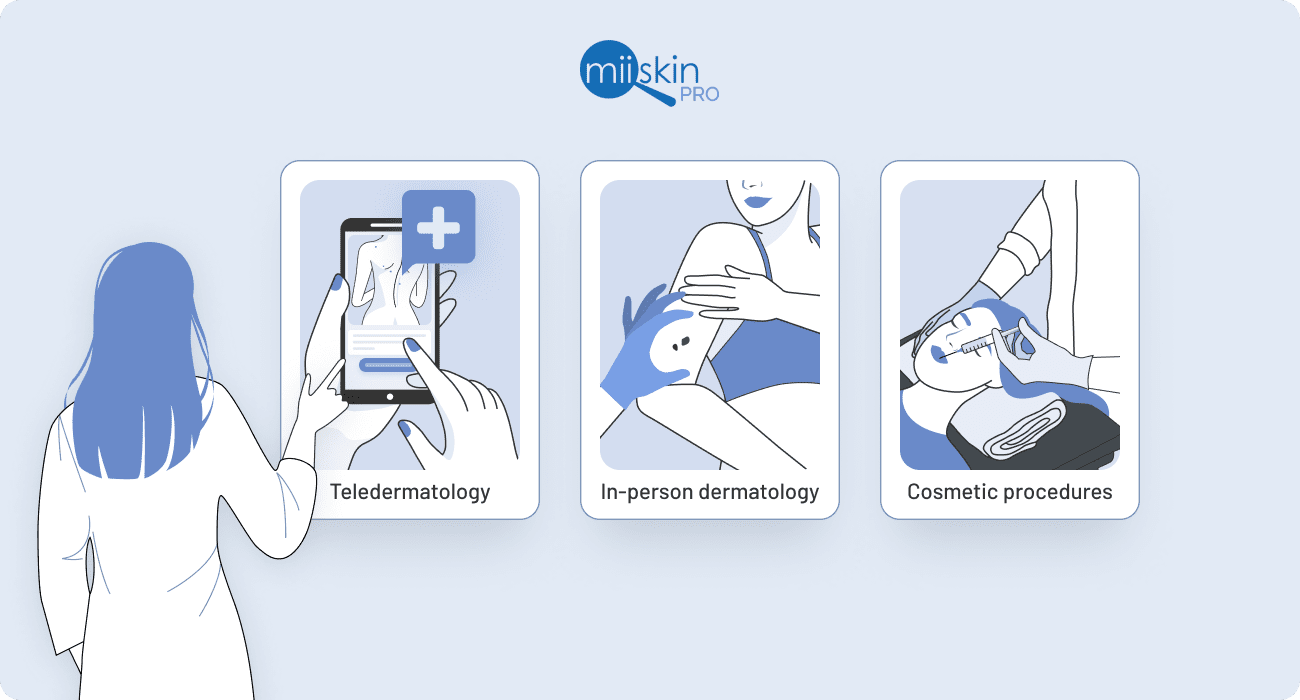7 Tips to Start Your Private Dermatology Practice
Get an overview of the things you need to consider if you are planning to set up a private dermatology clinic.
Author: Jennifer Highland, Content Manager of Miiskin | Reviewed by: Jon Friis, Founder, and CEO of Miiskin
Covered in this article:
Business plan | Secure funding | Choose your services | Hire the right people | Spend carefully | Offer telemedicine services | Invest in digital marketing
Are you considering starting your private dermatology practice? Or have you finally decided to open your own dermatology clinic? Congratulations, that is great! However, to ensure you succeed in this endeavor, you need to learn as much as possible on this topic.
Here are seven tips on starting your own medical office to ensure your private dermatology practice becomes successful.
Checklist for Starting a New Dermatology Practice
- Develop a business plan
- Secure funds for your business operations and growth
- Choose the services you want to offer
- Hire the right people, outsource when possible
- Spend carefully and invest in the essentials
- Provide telemedicine services and earn extra revenue
- Invest in digital marketing
How to Start a Private Dermatology Practice: 7 Tips Guide
1. Develop a Dermatology Business Plan
The first step for any small dermatology clinic is to develop a thorough business plan and open your own medical clinic; this is the first thing you need to get started with.
The business plan for your dermatology practice should focus on establishing the goals to operate and grow your practice. It should include these sections: finances, human resources, marketing strategy, physical location, equipment, and IT infrastructure.
- Executive summary: The executive summary gives an overview of the entire business plan and mentions the areas the business plan will cover.
- Business description: To start your own medical business, you need a comprehensive description of your business.
- Market analysis and marketing strategy: To start a private medical practice, one of the most important things to consider is your target market (clientele you want to attract) and Marketing Plan (how do you plan to attract that clientele).
- Competitive analysis: This section clearly outlines a comparison of your organization to your competitors.
- Business management: To open your own healthcare practice, you must consider the key stakeholders to support your organization’s strategy.
- Business operations: To start your own healthcare clinic, you need to describe how you plan to run your clinic and what services will you offer? This should also include information on how and where your company will operate, how many employees it will have, and other details related to your clinic’s operations, including equipment and IT infrastructure.
- Financial projection: Another important consideration when setting up your dermatology clinic is a projection of your expenses and the revenue you anticipate over the first years.1
You do not need to be an expert on everything, and you don’t need to do everything yourself; to set up your medical practice, you can always seek the assistance of business consultants.
2. Secure Funds for your Medical Business Operations and Growth
Business experts estimate that 20% of new businesses fail in their first year, and up to 45% fail in their fifth year because they run out of money.2 Based on these statistics, it is essential that you create a financial spreadsheet once you’ve come up with your business plan.
How do you intend to pay for the staff, commercial space, and equipment for the business? Review the financing options, available cash, investment, or funds available. Establish how much money you need to run your medical practice setup’s operations and growth options.
MIISKIN PROMO
Attract New Patients to your Medical Practice with the Miiskin platform
Skin Health Solution for Providers
Boost patient acquisition: The Miiskin website is visited by 250,000 patients every day; offer these patients care delivered by your practice.
Automate patient intake: Patients can fill out any intake forms, make payments and give consent via the Miiskin app.
Offer efficient care delivery: Triage patients, renew prescriptions and make routine visits more efficient with an asynchronous telehealth solution.
3. Choose the Medical Services you Want to Offer
What type of clientele do you want to attract to your own private dermatology clinic, and what services do you want to offer to attract such clientele? You can consider a mix of general in-person dermatology services, virtual dermatology services (commonly referred to as teledermatology), and cosmetic procedures. This mix of service offerings will ensure you can attract a diverse clientele, and you can always focus more on the services that have a higher demand.
It is also a good idea to call some of the dermatology clinics in the vicinity and check on the waiting times they have for new patients. Suppose the wait time is longer than a couple of weeks. You can tap on that revenue stream by investing in a store-and-forward teledermatology system; this will allow you to reduce the average waiting time for patients from 32 days to less than 48 hours.
Another idea is to review the different virtual dermatology services available so you can learn about the way they do things and replicate what you think may work for your private dermatology clinic.
It is important to know that teledermatology reimbursement is on par with in-person consultations by most private insurance companies in the U.S.
4. Hire the Right People, and Outsource when Possible
To set up your own private dermatology practice, you need clinical and non-clinical support. One of the first steps should be teaming up with one or two key stakeholders with business, finance, legal, and compliance experience.
These stakeholders should share your vision and bring different areas of expertise to the table to ensure your business can stay afloat and thrive. To keep costs low, outsource as many functions as possible such as bookkeeping and payroll.
You also need to hire good staff such as nurses, medical assistants, office managers, or receptionists. It is a good idea to hire them on a part-time basis in the beginning to save costs. However, when opening a private dermatology practice, it is essential to consider that every employee is responsible for making a patient’s experience positive.
Ensure your staff delivers a good customer experience to boost patient satisfaction, get patients who return repeatedly, and refer you to their network.
5. Spend Carefully and Invest in the Right Equipment
It is tempting to overspend during the initial stages of a business. But before you purchase expensive furniture or hire an interior designer, look at your business plan and your financial overhead with a long-term perspective. Consider your cash flow, start small, and allow your business to grow with time.
The process of acquiring patients goes hand-in-hand with investing in the right equipment. Once you have determined the areas you want to focus on, you can lease or purchase the essential dermatological tools and equipment and dermatology software for your specific needs.
6. Offer Telemedicine Services and Cater to Young, Digital Patients
You have probably heard of the many benefits teledermatology offers to patients and dermatologists:
- Increased revenue stream
- More convenience
- Reduced waiting times
- Effective utilization of resources
- Delivery of efficient care
- Caters to the digital patient
- Increases access for patients in remote locations
While all this is true, another significant benefit of telemedicine for your own private dermatology clinic is that it is probably not offered by your competitors. They have probably already established a solid patient base and have enough work to invest in new ways of doing things.
With good teledermatology software or teledermatology apps, you can easily increase provider capacity up to 20% and triage patients online to prioritize those who need urgent care.
You will also be able to provide virtual care to young, digital patients whenever convenient to them and you, without having to schedule an appointment. Patients can submit photos of their skin condition, chief complaint, symptoms, and other health-related data. These requests will be available to you as soon as they send them; you can view them when you have a patient cancellation or after your lunch break. You don’t need to be at the office. You can view and attend to these requests from your favorite coffee shop while sipping a latte.
You will also be able to conduct virtual prescription renewals four times as fast. The best part is that you get more flexibility on your schedule and a better work/life balance as a dermatologist, and you will also be able to provide virtual care to young, digital patients whenever convenient to them and you.
7. Invest in Digital Healthcare Marketing
Establishing a solid marketing strategy for your dermatology practice — including all aspects of digital marketing such as SEO, content marketing, and digital advertising— is essential to ensure your clinic’s growth.
Younger generations are digital natives, and to be able to attract new patients to your private practice, you need to be able to find them where they are, which is online. The only way to do this is by establishing a solid and trustworthy online presence and building a digital marketing strategy for your medical practice.
Conclusion
Creating the right plan is essential to the success of any small dermatology business. Hopefully, this article has provided you with a good head start and the necessary information to learn more about starting your own healthcare practice. The last step is to take action.
Reading more in-depth about this topic and talking to people who have started this journey before you will help you minimize risk while maximizing growth opportunities.
Consult a Board-Certified Dermatologist Now!

Download the Miiskin app to connect with independent, board-certified dermatologists who are licensed in your state. Answer a few questions, upload some photos and get a treatment plan in 1-2 days. Consultation price is $59 and medication renewals are only $39.
Online dermatology care is ideal for chronic dermatology conditions.
References:
1 https://www.indeed.com/career-advice/career-development/parts-to-a-business-plan/
2 https://www.investopedia.com/financial-edge/1010/top-6-reasons-new-businesses-fail.aspx/
3 https://patientengagementhit.com/news/long-wait-times-in-dermatology-harm-patient-experience-safety/









 Want to offer photo visits to your patients?
Want to offer photo visits to your patients?